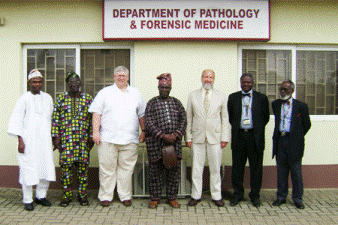Natural Resources, School of

Karl Reinhard Publications
Document Type
Article
Date of this Version
1992
Citation
Midwest Archeological Center Occasional Studies in Anthropology No. 26
Series Editor F.A. Calabrese
Prepared for Rocky Mountain Regional Office and Glen Canyon National Recreation Area at the U.S. Department of the Interior, National Park Service, Midwest Archeological Center, Lincoln, Nebraska 1992
Abstract
The Dan Canyon burial was discovered at a time when the philosophy, ethics, and legislation concerning the study of human remains are in a state of flux. A number of important sensitive issues germane to managers, archeologists, and American Indians are discussed in the introduction. The subsequent analysis provides a detailed scientific account of these remains and a glimpse of a segment of a people's past lifeway while remaining sensitive to the wishes of the American Indians.
The burial and associated grave goods of site 42SA21339 were exposed by wave action in a location frequented by boaters at the Glen Canyon National Recreation Area. The Park Superintendent made the decision that the burial should be removed immediately to prevent further damage by visitors and lake water. The Park Archeologist and other park personnel documented and mapped the site. Subsequently, two Native American groups were consulted concerning the disposition of the burial materials, the Navajo and the Hopi. The Navajos' response allowed up to a year for analysis, while the Hopi requested that analysis be limited to five months.
In analysis, several issues were addressed using a variety of data, including paleopathological, chronological, technological, social, and economic information. At the request of the Hopi, the methods used for recovery of data emphasized non-destructive and non-intrusive procedures.
The site is near Moqui Canyon, on the Colorado River arm of Lake Powell, on the west slope of the Red Rock Plateau, near the maximum range of both the Kayenta and the Mesa Verde Anasazi.
Consisting only of two features, the site includes the grave of a child with burial goods and a remnant of a small granary, with no other cultural materials. Burial goods include a variety of perishable and nonperishable goods, including an anomalous ceramic canteen in the style of Tusayan Blackon- red, but decorated with a white mineral paint. Compared with burial goods included with other Anasazi of the same age group, these goods are commensurate with those expected for an individual of average economic and social status. Artifacts indicate this burial is late PIlI, Horsefly Hollow Phase in the period A.D. 1210 to 1260, the final Anasazi occupation of this area (Lipe 1970).
The human remains and associated food remains indicate that this average, healthy child experienced periodic nutritional stress, probably due to an inadequate and homogeneous diet. The coprolites recovered from the burial are uniquely homogeneous, the macrobotanical portion consisting only of highly processed grass seed, probably all rice grass (Oryzopsis). Pollen extraction yielded mostly grass pollen (Poaceae). The remaining pollen suggested that Mormon tea (Ephedra) had been ingested, possibly medicinally, and that death occurred in winter or early spring. Developmental and other skeletal characteristics indicate this individual was approximately 3.5 years old at death and was in good health. Regularly spaced Harris lines indicate some form of periodic stress.
Investigations in nearby areas indicate that this was a period of environmental degradation and that Anasazi populations may have experienced nutritional stress or other consequential forms of physiological stress. Studies of both prehistoric populations and living populations suggest that a number of methods were employed to support individuals through periods of stress, and to promote the well-being of the group. This burial has provided much unique and important information regarding the economic and dietary systems, and the general health of an individual.
Reburial was conducted on March 6 and 7, 1991, near Page, Arizona, by representatives of the Hopi, Glen Canyon National Recreation Area, and the Midwest Archeological Center (MW AC). Research results were presented to the Hopi representatives on the evening of March 6, along with two copies of the draft report for review. This meeting allowed candid discussion regarding philosophies, research goals, laws, jurisdiction, and finances. The remains were reburied near their point of origin on March 7.
Higher res file (25 MB)
Included in
Archaeological Anthropology Commons, Ecology and Evolutionary Biology Commons, Environmental Public Health Commons, Other Public Health Commons, Parasitology Commons

